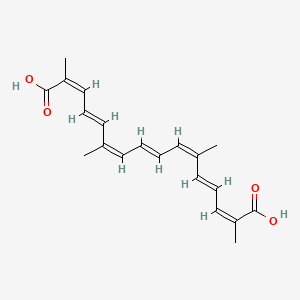

1. Oils, Saffron
2. 8022-19-3
3. .alpha.-crocetin
4. Oils, Crocus Sativus
5. Saffron C.i. 75100
6. Nsc407300
7. Hsdb 1949
8. (2z,4e,6z,8e,10z,12e,14z)-2,6,11,15-tetramethylhexadeca-2,4,6,8,10,12,14-heptaenedioic Acid
9. 8,.psi.-carotenedioic Acid
10. Chembl1993367
11. Mfcd00064590
12. Zinc33985645
13. 2,6,8,10,12,14-hexadecaheptaenedioic Acid, 2,6,11,15-tetramethyl-
14. 2,6,8,10,12,14-hexadecaheptaenedioic Acid, 2,6,11,15-tetramethyl-, (all-e)-
1. Transcrocetin
| Molecular Weight | 328.4 g/mol |
|---|---|
| Molecular Formula | C20H24O4 |
| XLogP3 | 5.4 |
| Hydrogen Bond Donor Count | 2 |
| Hydrogen Bond Acceptor Count | 4 |
| Rotatable Bond Count | 8 |
| Exact Mass | 328.16745924 g/mol |
| Monoisotopic Mass | 328.16745924 g/mol |
| Topological Polar Surface Area | 74.6 Ų |
| Heavy Atom Count | 24 |
| Formal Charge | 0 |
| Complexity | 608 |
| Isotope Atom Count | 0 |
| Defined Atom Stereocenter Count | 0 |
| Undefined Atom Stereocenter Count | 0 |
| Defined Bond Stereocenter Count | 7 |
| Undefined Bond Stereocenter Count | 0 |
| Covalently Bonded Unit Count | 1 |
EXPL THER The antitussive activity of Crocus sativus stigma and petal extracts and its components, safranal and crocin, was evaluated using the nebulized solution of citric acid 20% in guinea pigs. The extract and agents were injected intraperitoneally. The ethanolic extract of C. sativus (100-800 mg/kg) and safranal (0.25-0.75 mL/kg) reduced the number of cough. The ethanolic and aqueous extracts of petal and crocin did not show antitussive activity. /Extracts of Stigma Croci/
PMID:16814486 Hosseinzadeh H, Ghenaati J.; Fitoterapia. 77 (6): 446-8 (2006)
EXPL THER Crocus sativus L. (saffron) is used in folk medicine, for example as an antiedematogenic agent. /The authors/ aimed to evaluate the antinociceptive and anti-inflammatory activity of saffron extracts in mice. /They/ used aqueous and ethanolic maceration extracts of Crocus sativus L. stigma and petals. Antinociceptive activity was examined using the hot plate and writhing tests. The effect of extracts against acute inflammation was studied using xylene induced ear edema in mice. The activity of the extracts against chronic inflammation was assessed by formalin-induced edema in the rat paw. In the hot plate tests, intraperitoneal injection of both extracts showed no significant antinociceptive activity in mice. The extracts exhibited antinociceptive activity against acetic acid induced writhing. Naloxone partially blocked only the antinociceptive activity of the stigma aqueous extract. Only the stigma extracts showed weak to moderate effect against acute inflammation. In chronic inflammation, both aqueous and ethanolic stigma extracts, as well as ethanolic petal extract, exerted anti-inflammatory effects. /The authors/ conclude that aqueous and ethanolic extracts of saffron stigma and petal have an antinociceptive effect, as well as acute and/or chronic anti-inflammatory activity. /Stigma extracts/
PMID:11914135 Full text: https://www.ncbi.nlm.nih.gov/pmc/articles/PMC101384 Hosseinzadeh H, Younesi HM.; BMC Pharmacol. 2: 7 (2002)
EXPL THER Administration of a monthly intramuscular injection of crocetin (dose not specified) to rabbits fed an atherosclerosis-inducing diet reduced serum cholesterol concentrations by 50%, and reduced the severity of atherosclerosis by ~30%. /Crocetin/
WHO Monographs on selected medicinal plants 3: 126-135 (2007); Available from, as of October 23, 2013: https://apps.who.int/medicinedocs/en/m/abstract/Js14213e/
EXPL THER The antioxidant effects of the stigmas were assessed in a clinical trial involving 30 subjects in three groups: 10 healthy volunteers, 10 patients with coronary artery disease and 10 healthy controls. The two test groups received 50 mg of Stigma Croci in 100.0 mL of milk twice daily for 6 weeks, the controls received milk only. Lipoprotein oxidation in blood samples decreased by 42.3% in healthy volunteers (P < 0.001) and 37.9% (P < 0.01) in patients with coronary artery disease compared with controls. /Stigma Croci/
WHO Monographs on selected medicinal plants 3: 126-135 (2007); Available from, as of October 23, 2013: https://apps.who.int/medicinedocs/en/m/abstract/Js14213e/
For more Therapeutic Uses (Complete) data for SAFFRON OIL (7 total), please visit the HSDB record page.
At doses of 5.0 g or more, Stigma Croci may cause serious adverse reactions. Overdose of Stigma Croci (12.0-20.0 g/day) may be fatal. /Stigma Croci/
WHO Monographs on selected medicinal plants 3: 126-135 (2007); Available from, as of October 23, 2013: https://apps.who.int/medicinedocs/en/m/abstract/Js14213e/
Stigma Croci may induce uterine contractions and is therefore contraindicated during pregnancy. Owing to a lack of safety data, use of the stigmas in children and nursing mothers should be restricted to normal food use. Stigma Croci is contraindicated in bleeding disorders. /Stigma Croci/
WHO Monographs on selected medicinal plants 3: 126-135 (2007); Available from, as of October 23, 2013: https://apps.who.int/medicinedocs/en/m/abstract/Js14213e/
Stigma Croci inhibits platelet aggregation and should therefore be used with caution in patients taking anticoagulant or antiplatelet drugs. /Stigma Croci/
WHO Monographs on selected medicinal plants 3: 126-135 (2007); Available from, as of October 23, 2013: https://apps.who.int/medicinedocs/en/m/abstract/Js14213e/
The lethal dose of Stigma Croci is reported to be 20.0 g... /Stigma Croci/
WHO Monographs on selected medicinal plants 3: 126-135 (2007); Available from, as of October 23, 2013: https://apps.who.int/medicinedocs/en/m/abstract/Js14213e/